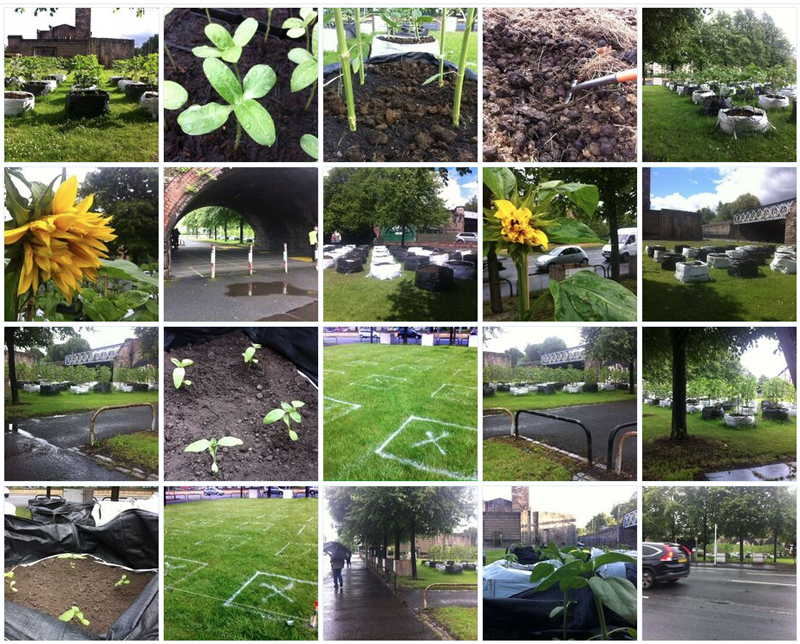A YELLOWFIELD flourished in a gap site in the Glasgow
Image of YELLOWFIELD in May 2015 before it fully flourished.
We hope you find this a project of interest for your local community and that you would consider assisting us with your neighbours, local businesses and community groups. This landscape recovery initiative was called 'YELLOWFIELD'. Located at the MOBILELAND Garden in the Gorbals, YELLOWFIELD was established to reactivate an existing brownfield site. It started on 1 May 2015 with the planting of 200 sunflower seedlings and ended in November 2015 when the plants’ annual lifespan was over. 50 planters, each containing four large sunflower plants (using the principle of 'phytoremediation' to regenerate the soil enabling its physical and biological recuperation through temporary greenery), enabled the site to flourish, and demonstrated community led place making. This work synchronised with ‘Green Glasgow 2015’ by Glasgow City Council.
The YELLOWFIELD project created environmental awareness and debate on smart and sustainable ideas locally, through the transformation of a brownfield site into an open public garden with ecologically productive land. This bottom up intervention aims to re-animate future brownfield sites - from Brown to Green. Sunflowers are a very effective plant for ‘cleaning’ soils contaminated with industrial waste. They are now regarded worldwide as a clean, cost effective and environmentally friendly way to reclaim and reuse land. Sunflowers are being used because of their quick growth and size and their visual appeal. The sunflowers take in the toxins from the soil as they would nutrients and at the end of the year’s growth the plant is removed from the site and destroyed.
YELLOWFIELD is a pioneering initiative led by The University of Strathclyde. The main team from the Department of Architecture, Dr Christine Switzer of Civil & Environmental Engineering and Amanda Currie, a Landscape Artist and Gardener who supplied the photographs below. The site is adjacent to the Caledonia Road United Presbyterian Church in the Gorbals district of Glasgow, designed by Alexander "Greek" Thomson in the 1850s.
For further information please contact the department: architecture@strath.ac.uk

MOBILELAND
This project aimed to develop urban places, to play and learn about nature and technology, as well as improving the participants' personal development and sociability. The worldwide phenomenon of shrinking cities has generated many derelict urban voids. Continuing neglect and urban inertia will mean that these spaces have a detrimental effect on the local neighbourhoods’ environmental quality, social health and the local economy.
Over the summer of 2015, in collaboration with Glasgow City Council ‘Stalled Spaces’ initiative and others, MOBILELAND in Glasgow aimed to develop places as well as helping locals. MOBILELAND gardens offer affordable methods of gardening, food production and ‘harvesting’ for inner cities. A ‘Mobileland Garden’ (see website for further information) is a project that aims to:
- act as a catalyst for community action
- improve the aesthetics of the area
- rebrand stigmatised residential areas
- contribute to the green infrastructure of our city
- generate safe public places for the local residents
MOBILELAND AIMS - Reduce, Reuse and Recycle
MOBILELAND (c) is a Scottish Eco-design Vertically Integrated Project (VIP) led by Dr Cristian Suau, together with the international collaboration of Glasgow City Council Stalled Spaces Project, Glasgow Project Office, ECOFABRICA, designers, landscape architects and students from The University of Strathclyde.
The proposal is for a versatile DIY landscaping scheme which has the potential to enhance public spaces and offer community groups, schools and those without gardens their very own portion of land. Its aim is to produce pieces of radical landscape architecture based on the theme of reduce, re-use and recycle ‘on wheels’.
The MOBILELAND Glasgow VIP offers diverse ways of exchanging knowledge between students, professionals and the local community. This is achieved through experiential learning, story telling and performance, future problem solving and proactive learning outside the 'classroom'.

